Cervical Spine Fusion without Plates
 Summary:
Summary:- Fusion does not require the traditional “plate”
- Stalif C completely fits in disc space
- Allows for less tissue disruption
A new, advanced implant for cervical spine fusion surgery, called Stalif C®, is now being used by Dr. Maroon for many of his fusion patients as an alternative to traditional plate fusion. (See Testimonials BELOW)
Background
In the spine, between all the vertebrae (also known as the building blocks that make up our spine) there are intervertebral discs. These discs are softer than the bone of the vertebrae and they provide shock absorption and flexibility in the back, but they also help keep the proper distance between the vertebral bones. Certain conditions can cause a disc to collapse (flatten), meaning the distance between the adjacent two vertebrae becomes narrower. This narrowing compresses the spinal nerves, which can result in severe pain, numbness and eventually even disability. If a discs collapses in the cervical area of the spine (the neck), cervical fusion may be necessary.
What is Cervical Fusion Surgery?
Cervical spine fusion is surgery to permanently connect two adjacent vertebrae in the cervical spine, eliminating motion between them. In some cases, even more than two vertebrae can be fused. For this fusion, cervical spine implants can be used to provide stability to the spine and/or to help decompress the specific nerves or the spinal cord that had been under pressure due to the collapsed disc. Consequently, the symptoms stemming from the compression of nerve(s) will be relieved as well
The surgery is done by entering the front of the neck in order to reach the front part of the cervical spine. The fusion will be done between the vertebrae that are above and below the collapsed disc space. After the disc space has been opened and the compressed disc has been removed, a spacer made of either bone or more commonly a hard plastic material is placed within the intervertebral disc space. The spacer is designed to keep the intervertebral space open in order to prevent collapse and nerve compression in the future.
The “traditional” method of fusion involved placing a piece of bone in the disc space to promote bone growth between the two vertebrae, and holding this in place with a metal plate that is being screwed into the vertebra above and below.
What is a Stalif C® Fusion?
Download Patient Brochure: STALIF C PATIENT GUIDE
Stalif C® is one of the newest devices in anterior cervical spine surgery. It is an intervertebral spacer that does not require an additional plate system to hold it in place. Made from a hard plastic material this fusion spacer can be completely placed into the intervertebral disc space after the disc has been removed and locked in place with three screws (see photo).
This system offers several major advantages:
- It is completely enclosed within the intervertebral space so the esophagus and other structures that run along the front of the cervical spine are less likely to be irritated.
- Because there is only one implanted device to be inserted (as compared to both a spacer and a separate screw/plate system) the amount of surgical time can be reduced.
- There have been several studies suggesting that if the cervical plate is placed too close to the disc space above or below the surgical site, there may be an increased risk of accelerated degeneration at those levels. Because the Stalif C® system is completely within the intervertebral space, this is not a concern.
- The system is ideal for re-operation surgery for patients who have already had a plate system installed, since the placement of an intervertebral fusion implant such as Stalif C® does not require removal of the previously implanted plate system (see photo).
What is the bottom-line?
Although many of the described advantages may seem somewhat technical, these systems represent a significant advancement for both the patient and surgeon. Because of unique anatomy and other surgical consideration not all patients are candidates for an intervertebral fusion implant such as Stalif C®. If you have any question s about what type of cervical fusion device is best for you, contact Dr. Maroon directly though this website.
Tri-State Neurosurgical Associates-UPMC
Office Addresses:
Administrative Oakland Office
Presbyterian University Hospital
Department of Neurosurgery
Suite 5C
200 Lothrop Street
Pittsburgh, PA 15213
Phone: 1-888-234-4357
© 2013 Tri-State Neurosurgical Associates – UPMC
Watch Video Below




 Dr. Maroon received an athletic scholarship to Indiana University in Bloomington, Indiana where as an undergraduate, he was named a Scholastic All-American in football. Dr. Maroon has successfully maintained his personal athletic interests through participation in 9 marathons and more than 72 Olympic-distance triathlon events. However, his greatest athletic accomplishment is his participation in 8 Ironman triathlons (Hawaii – 1993, 2003, 2008, 2010, 2013; Canada – 1995; New Zealand – 1997; Germany – 2000), where he usually finishes in the top 10 of his age group. Recently, in July 2012 and 2013, he finished second and third, respectively, in his age group in the Muncie, Indiana half Ironman triathlon. In October 2013 he completed his 5th World Championship Ironman in Kona, Hawaii.
Dr. Maroon received an athletic scholarship to Indiana University in Bloomington, Indiana where as an undergraduate, he was named a Scholastic All-American in football. Dr. Maroon has successfully maintained his personal athletic interests through participation in 9 marathons and more than 72 Olympic-distance triathlon events. However, his greatest athletic accomplishment is his participation in 8 Ironman triathlons (Hawaii – 1993, 2003, 2008, 2010, 2013; Canada – 1995; New Zealand – 1997; Germany – 2000), where he usually finishes in the top 10 of his age group. Recently, in July 2012 and 2013, he finished second and third, respectively, in his age group in the Muncie, Indiana half Ironman triathlon. In October 2013 he completed his 5th World Championship Ironman in Kona, Hawaii.
